
Words from the Dean
July 2017
Happy midsummer! As we get ready for the next academic year, I am excited to share the investments we are making to benefit our student success, faculty success and innovative programs. These three areas ensure that our College continues to thrive.
This year we are investing in Student Success by enhancing student recruitment, retention rates and graduation rates. These activities will not only benefit our students, but will also enhance revenue for our departments and for OSU. We are doing this by:
- Increasing our outreach to high schools and community colleges,
- Enhancing our online presence,
- Overhauling our website to be outward looking and student-centric,
- Developing new recruitment marketing, and
- Hiring a transfer student advisor who is shared with the Division of Undergraduate Studies.
We are also supporting student success through:
- Proactive advising,
- Renovating the Mathematics and Statistics Learning Center (MSLC),
- Creating alternative pathways in mathematics and statistics, and
- Ramping up professional and career development and internship experiences.
And to make sure that students are aware of all these resources and opportunities, we are increasing student marketing through email, web stories and social media.
Secondly, we are investing in Faculty Success by developing support systems that enhance our efforts and success in research, teaching and engagement. We are expanding professional development for faculty, including:
- Communication skills,
- Networking, and
- Bridge funding.
We are continuing to:
- Offer faculty grant support through workshops and one-on-one proposal consultation,
- Hire in strategic areas – in research and areas that lead to new revenue generation,
- Recognize faculty excellence and scholarship such as the three new College of Science Awards established this spring, as well as
- Raise the visibility of outstanding faculty research, teaching and scholarly activities through marketing.
We are excited that at least seven of our junior faculty have submitted NSF CAREER proposals this month thanks to help from Bettye Maddux, Don Forbes and Doug Keszler. We wish them and other faculty with pending grant proposals much success.
And lastly, we are investing in Innovative Programs that support both student and faculty success and help drive significant revenue for our College and ultimately for OSU. We are:
- Leveraging the success of our M.S. in Data Analytics program,
- Pursuing significant collaborative research,
- Broadening participation in workforce development grants,
- Expanding our Ecampus presence by developing “First Two Years Online” programs for undergraduates and full online degree programs,
- Accelerating adaptive learning technologies in science courses,
- Launching new Professional and Continuing Education (PACE) courses, and
- Developing new certificate and undergraduate programs in data science and/or measurement science.
We are also embarking on ambitious plans to establish a presence for the College of Science in the Portland market.
Several of these are underway within departments and at the College level. All of these efforts will advance our strategic goals and transform our College from good to great. I welcome your ideas as we work together to enhance faculty and student success, while blazing a growth trajectory in both our accomplishments and our finances.
Hope you are all continuing to enjoy a productive summer and this beautiful weather.
All the best,
Sastry
Sastry G. Pantula
Dean, College of Science
All the news that’s fit to print.
Please submit news, honors and awards, discoveries, events, research funding, student news, alumni updates and more. Just send us a quick email by the end of the month.

RESEARCH EXCELLENCE
Research Highlights
Read more of the most recent research happening in our College online.
Microbiologist Kimberly Halsey has discovered that diatoms really do have sex and ammonium puts them in the mood—key findings as diatoms hold great potential for both bioenergy and biotech.
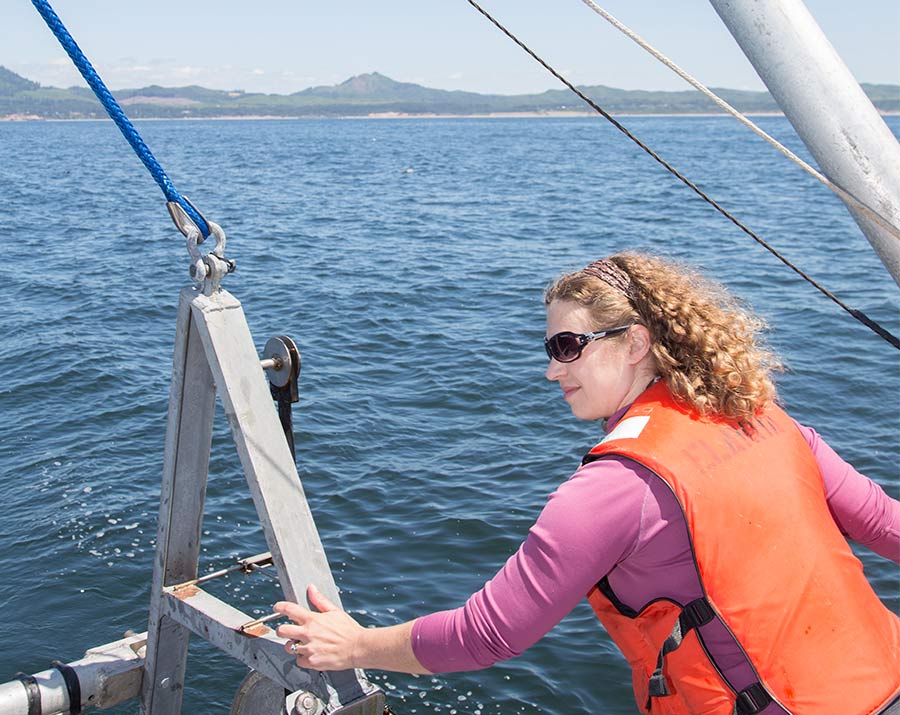
Sarah Henkel at sea. Photo by Chris Beccera.
Marine biologist Sarah Henkel’s survey of sea floor animals is helping the development of offshore renewable energy facilities on the west coast.
Doug Keszler has played a leading role in helping the university obtain its new spectroscopy instrument, a high-tech research instrument that will make OSU’s surface characterization laboratory a major resource for scientists throughout the Pacific Northwest. The $1.6 million instrument, an ambient-pressure X-ray photoelectron spectroscopy system, is the first instrument of its kind in the United States to incorporate an ambient-pressure scanning tunneling microscope, which enables imaging of surfaces with atomic resolution. The new system brings unique research capabilities and will play a key role in advancing OSU’s strategic research areas of clean energy, advanced manufacturing and materials science.

Astronomy instructor Randy Milstein has been giving many presentations about the solar eclipse as part of OSU150 Space Grant Festival: A Total Eclipse Experience. An Astronomer-in-Residence for the Oregon NASA Space Grant Consortium, Milstein has talked about the cultural history, viewing safety and physics of the solar eclipse. He has also discussed the earliest human records, significant historical events and how human understanding of solar eclipses evolved with advances in astronomy.
Research Funding
Research funding continues upward trajectory
College of Science faculty were awarded $18.7 million in research grants and awards in FY17, the second highest year since FY2013 and an increase of 54% from last year. The good news is that the three-year moving average of awards shows a continued upward trajectory! The College received 3.7% more grants and contracts than in FY16.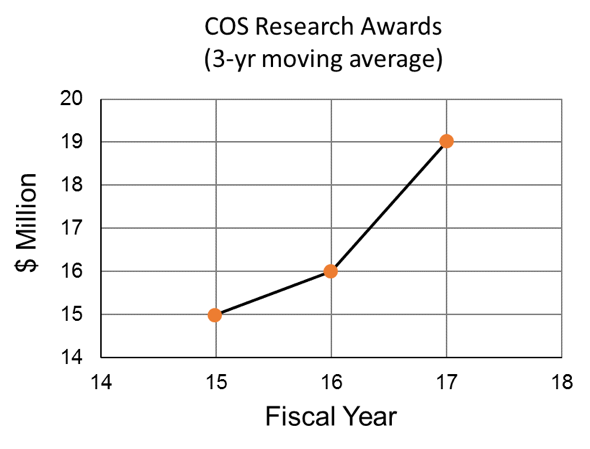
The breakdown of research funding for FY17 is below.
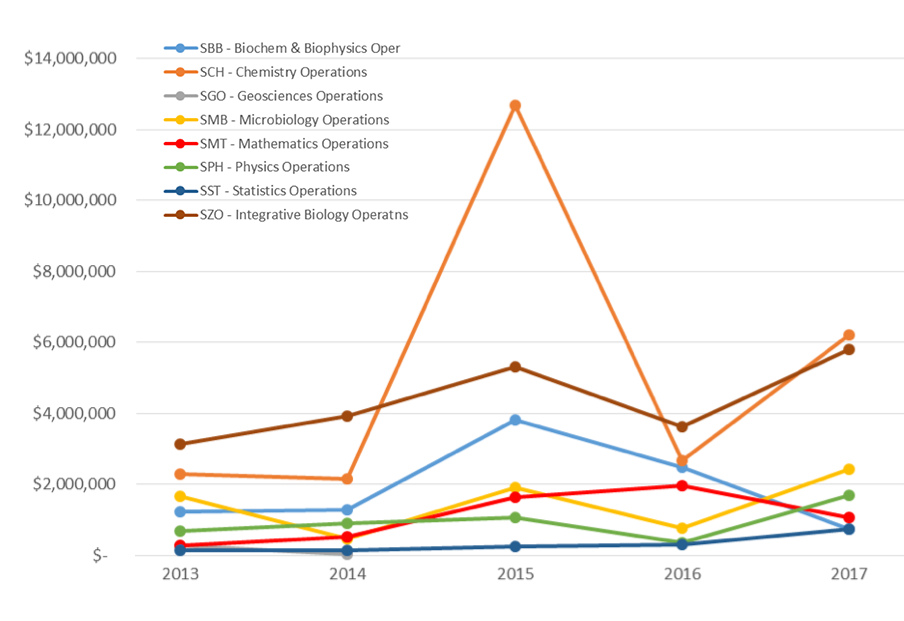
Most of the College’s research funding for FY17 was from federal agencies, with the National Science Foundation awarding 61% of the grants, the National Institutes of Health 4%, sub-awards contributing 8% (these funds are pass-throughs of NSF, NIH, DOE grants, etc., where the PI is located at another institution), U.S. Army 2%, other 20% (other federal agencies, industry, nonprofits, foundations), and Department of Energy 7%.
Congratulations to these faculty who received grant funding of $1 million and above, an impressive feat given the competitive climate for federal funding.
- Douglas Keszler has received a two-year grant renewal of $3.1M from NSF’s Directorate for Mathematical and Physical Sciences for the Center of Sustainable Materials.
- Bruce Menge and co-PIs Francis Chan and Jack Barth received a $2M grant from the David and Lucile Packard Foundation to support PISCO to increase the consortium’s global impact by training the next generation of interdisciplinary marine scientists and by continuing to build a database that is accessible to marine researchers worldwide.
- Virginia Weis has been awarded a $1.88M grant from NSF’s Directorate for Biological Sciences that was part of a collaborative, new $14M NSF program for enabling discovery through genomic tools. She was one of eight researchers nationwide selected for the program.
The grant amount includes awards to faculty who are currently supported by the prestigious NSF CAREER Awards—the NSF’s top award given to junior faculty members for outstanding research and the effective application of that research in university teaching and education—as well as faculty who were awarded highly competitive funds for various research projects, ranging from support for undergraduate mathematics research to the impact of climate change.
While many faculty received grants in FY17, below are some notable awards.
- May Nyman received a four-year U.S. Department of Energy grant for $540K for her project “Counterions for controlled dissolution, precipitation, and stabilization of molecular clusters and extended lattices.”
- Ethan Minot received a three-year NSF grant for $400K for his project “Beyond the Shockley-Queisser limit: understanding and controlling carrier multiplication in carbon nanotube pn junctions.”
- Mary Beisiegel received a two-year NSF grant for $296K for her project, EAGER: Exploring mathematics graduate training assistants” development stages for teaching math.
- Matt Graham and Paul Cheong received a $274K grant from Apple, Inc. to collaborate on a project, “Electronic & Structural Characterization of Amorphous IGZO Materials.”
- Lisa Madsen was awarded a $79K grant from the USDA Forest Service for a project on spatial copula modeling of forest inventory variables.
Congratulations to the following faculty on their recent successes:
- Maria Franco received a $653K grant from the U.S. Department of Defense for her project, “Nitrated Proteins as a Target for Drug Development in Neurofibromatosis Type 2.”
- Jerri Bartholomew was awarded $404K by the Oregon Department of Fish and wildlife for a Fish Health Graduate Research Fellowship in Microbiology.
- Oskana Ostroverkhova received a three-year, $410K NSF award for her project “Naturally produced fungal compounds for sustainable (opto)electronics.”

CONGRATULATIONS
National Honors
Oksana Ostroverkhova was selected by the American Physical Society as Woman Physicist of the Month for May 2017. Congratulations!
Biologist Andrew Bouwma and Genevieve Weber (Department of Botany and Plant Pathologist) and OSU Ecampus won an annual Eduvision award last October for “developing a groundbreaking, online biology lab series and 3-D animation project” exemplifying “creative use of technology to boost student success.” Belated Bravo!
University Honors
Outstanding! Three faculty are receiving the University’s most prestigious annual awards for exceptional teaching and advising. The awards will be formally announced at the 2017 University Day on September 18, 2017. Congratulations to Kevin Ahern, Henri Jansen, and KC Walsh for their passionate dedication, hard work and distinguished achievement in helping our students reach their potential. Read more on iMPACT.
Student Honors and Programs
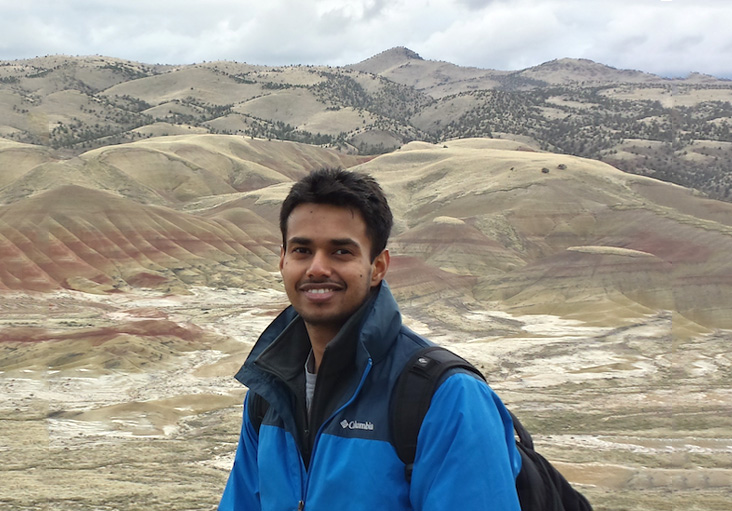
Atul Chhotray
Atul Chhotray was awarded the 2017 Physics Department Graduate Research Award. A native of India, Atul joined OSU in 2014 as a transfer student from North Carolina State University. His research in the computational astrophysics group of Davide Lazzati is an effort to better understand the radiation properties and acceleration mechanism of baryonic jets from gamma-ray bursts and blazars.
 Biochemistry and Biophysics graduate student Nathan Jespersen in the Barbar Lab is a recipient of a 2017–2018 STEM Chateaubriand Fellowship from the Embassy of France in the United States. The Université Paris-Saclay – Institute for Integrative Biology of the Cell will co-fund his fellowship to conduct research on “Elucidating the Role of LC8 in Rabies Viral Infection.”
Biochemistry and Biophysics graduate student Nathan Jespersen in the Barbar Lab is a recipient of a 2017–2018 STEM Chateaubriand Fellowship from the Embassy of France in the United States. The Université Paris-Saclay – Institute for Integrative Biology of the Cell will co-fund his fellowship to conduct research on “Elucidating the Role of LC8 in Rabies Viral Infection.”
Students experience a summer of data science research
An award-winning and nationally recognized Research Experiences for Undergraduates (REU) Program in Statistics draws talented, underrepresented minority students to campus for a summer of computational and data-driven research. Yet another unique statistics REU exposes students to cutting-edge interdisciplinary research in data analytics and microbiology. But it doesn’t end there! OSU is the foremost place for undergraduate research in quantitative sciences this summer. The longstanding and prestigious REU Program in Mathematics at OSU is exposing 10 students from across the country to the joys of mathematical research.

REVENUE AND INVESTMENTS
Significant drop in student credit hours
As we look ahead to fall, we need to focus on increasing student credit hours taught in our college. During the past four years, the total number of these credit hours have been decreasing each year. The decrease is significant—about 12,000 student credit hours, or 4% of total credit hours compared to FY13. As you know, this directly impacts our revenue to the university and eventually to our college. Some departments like chemistry and mathematics have seen a significant decrease, whereas others saw an increase during this period.
In OSU’s proposed budget model, a 4% reduction in our credit hours over the past four years would amount to a loss of between $1.4M to $4M annually in our College, depending on the actual distribution of undergraduate and graduate credit hours. It is essential that each department determine where there is a potential to increase student credit hours and/or contain or reduce our expenses to match our anticipated needs/revenue.
As we have discussed recently in our leadership meetings, some of the decrease in student credit hours may be attributed to a variety of factors. You may have other reasons and potential solutions as well. Please discuss them in your department, and share with the Dean’s Office. Possible reasons may be:
- Oregon Promise program – the state of Oregon approved an investment of $40M to continue the high-demand Oregon Promise program for 2017-19. The program offers affordable college pathways for Oregonians by paying community college tuition for recent high school graduates. This may reduce the number of students enrolling in courses at OSU for their first two years and consequently impact our student credit hours and number of transfer students.
- More students are taking courses elsewhere, such as community colleges, online at other universities, or they bring AP credits to OSU.
- Other colleges at OSU have changed their science and mathematics requirements or are offering alternative courses
- OSU’s tuition plateau has been eliminated so students have to pay for each course they take. Previously full-time students could take a heavier course loads for a flat fee.
- More students are successfully passing our courses without having to repeat them. (Decreased DFW rates are a good thing!)
- Decreasing enrollments in other majors which impact the number of students who enroll in science courses.
Admittedly, many of these factors are beyond our control and are happening across the country. We very much appreciate everything you are doing to help students in your courses to be successful. Are there some additional ways we may be able to influence to reverse the trend? For example,
- Keeping our courses more relevant to other majors
- Making our courses more welcoming and inclusive
- Staying connected with other colleges about their changing needs and curricular changes
- More creatively and effectively supporting our students’ success
- Developing relevant Ecampus, summer and trailer courses that meet market demand
- Partnering with community colleges
- Reducing costs to reflect our current student credit hour generation
- Others…
We appreciate your thoughts and are really grateful for the hard work all of you are putting in to enhance our students’ success.

MEET THE DEAN’S OFFICE
Our College is investing strategically in the team in the Dean’s Office in order to provide a greater level of support to our faculty, students and departments as well as to significantly enhance our visibility regionally and nationally among our peers and our alumni.
We are extremely proud of the outstanding people we have recruited for the Dean’s Office. We are also very grateful to the service we receive from Mark Johnson, Nick Dollar and Jennifer Hill in ASBC, and the COSINE team led by Andrew Wheeler. We appreciate the teams that support our NMR, EM and MaSC Facilities. They are all instrumental in helping our faculty, students, alumni and departments—our OneScience community—succeed.
Who’s Who?
Our Associate Deans
They have many responsibilities on our campus, and they are our face to the campus units.
- Matt Andrews—Strategic Initiatives and Administration (1.0 FTE)
Supports strategic initiatives, develops policies and operating procedures, coordinates promotions and tenure process and annual evaluations, manages leadership meetings, leads resource planning, administers SURE Science program among other areas.
Note: Currently, Matt is serving as interim head of our Chemistry Department (0.5 FTE). - Doug Keszler—Research and Graduate Studies (0.5 FTE)
Provides grant training, supports faculty professional development, devises startup packages, guides resource management, leads research development, assists with strategic visioning and innovation, directs strategic plan working groups, guides graduate programs and diversity, among other areas. - Staci Simonich—Academic and Student Affairs (0.5 FTE)
Guides undergraduate curricula, leads student success initiatives, manages assessment, guides diversity initiatives, oversees academic dishonesty case management, leads strategic initiatives, administers our scholarship program, advises student advisory board, among other areas.
Our Marketing Team
- Debbie Farris—Marketing Director (1.0 FTE)
Sets the marketing vision to achieve our strategic goals; promotes faculty, students and alumni accomplishments and stories; develops departmental alumni newsletters, alumni magazine and college newsletter; manages the website, develops student recruiting and program marketing materials; guides alumni relations; among other areas. - Srila Nayak—Writer/digital communications (part-time)
Writes faculty, student and alumni stories, develops news releases, interviews faculty/alumni/students, coordinates videos, coordinates email campaigns, manages social media; among other areas. - Sharon Betterton—Graphic Designer (1.0 FTE)
Develops creative concepts and designs for posters, newsletters, brochures, magazines, event programs, banner, graphics, email campaigns, website; manages website; manages photo library; helps manage and implement COS brand; among many others. - Katharine de Baun—Temporary marketing manager/project leader (part-time)
Manages projects, enhances workflow and project coordination; writes web stories and news releases; writes marketing publications (annual report, email campaigns, brochures and newsletters); among many others.
Student Professional Development Team
- Chris Larson—Director of Corporate Partnerships (1.0 FTE)
Develops integrated professional development programs for all our students; supports student retention and student success; develops internship opportunities and guides career planning. - Chelsea Wolk—Assistant Director of Strategic Programs (Supported on grant funding from Chris/Doug)
Develops personal skills modules for students; helps develop PACE courses; coordinates SURE Science program, among others. - Lyn Riverstone—Associate Director of Professional Development Integration (Supported 0.5 FTE by grant from Chris/Doug).
Develops personal skills modules for students, helps develop PACE courses, among others.
Note: Lyn’s other 0.5 FTE is in the Mathematics Department as instructor. - Claire Wu—Assistant Director of Career Development (supported fully by OSU’s Career Development Center)
Advises our students on career and internship opportunities; visits orientation classes to promote career development; develops programming and events to promote career readiness; provides one-on-one career counseling to students; connects science alumni with our students in meaningful ways, among others.
Our Advisors
- Heather Arbuckle—Head Advisor (1.0 FTE)
Manages all advising in our College; coordinates advisors; represents the College on university committees; develops advising strategies, processes and initiatives; manages Peer Advisors; oversees our new student orientation (START); administers our scholarship program; among others. - Jennifer McKee—STAR Advisor (0.6 FTE COS, 0.4 FTE DUS)
Advises science students in academic difficulty, leads the START program for new students, provide relevant advising and student data to the College; among others. - Peer Advisors—Student workers
Advise our students and serve as ambassadors for our College.
Key Personnel
- Kim McQueen—Executive Assistant to the Dean (1.0 FTE)
Manages dean’s calendar and appointments, mail, travel, etc.; manages purchasing; serves as office manager; manages work study students in the Dean’s Office; is the face of the college; among others. - Tze-Yiu Yong—Data Analyst/Event Manager (1.0 FTE)
Manages student and scholarship data from various sources and analyzes; helps administer student scholarships, manages OSU Foundation financial accounts, manages event coordination and support, provides conference planning support; coordinates donor stewardship; among others. - Gabrielle James—Special Assistant to Associate Deans, Marketing Director and Dean (1.0 FTE)
Supports Student Success initiatives; coordinates Peer Advisors; supports student recruitment efforts; coordinates Student Success Center events; manages outreach activities; among others. - Bettye Maddux—Grant Support (currently supported by CSMC center in Chemistry Department)
Supports faculty success; provides grant support and proposal consultation; communicates grant and funding opportunities to faculty, students and postdocs; among others. - Anne Murphy—OSUF Development Officer (no funding from COS)
Guides all of the fundraising strategies of the departments and college with our fundraising; supports donor cultivation and stewardship efforts; leads our development activities; among others.
We have an outstanding team that is helping everyone across our College and is ready to help with your success. We are extremely proud of the service with a smile that they provide to ensure we are successful and visible. How can the Dean’s Office support your success? Please do not hesitate to contact us!
I am very grateful to the support from the Provost Office as a part of the Dean’s startup to invest in support systems to help our faculty and students. The following table summarizes the expenses in the Dean’s Office in recent years.


College News
Saving new students from summer melt
In an attempt to stave off “Summer Melt”—a phenomenon that educators use to refer to the increasing trend of students who leave high school with college plans yet never make it to campus in the fall—the College launched a marketing campaign to target science students who have been admitted and/or who have even paid their deposit. The data suggests that 10–40% of low-income students melt nationally. Low-income and first-generation college students, in particular, can lose momentum when they leave the support system of their high school and are at an increased risk of melting away.
Cost, anxiety about leaving home and difficulty understanding all the college forms and requirements are among the most common reasons that students drop off the college track in the summer.
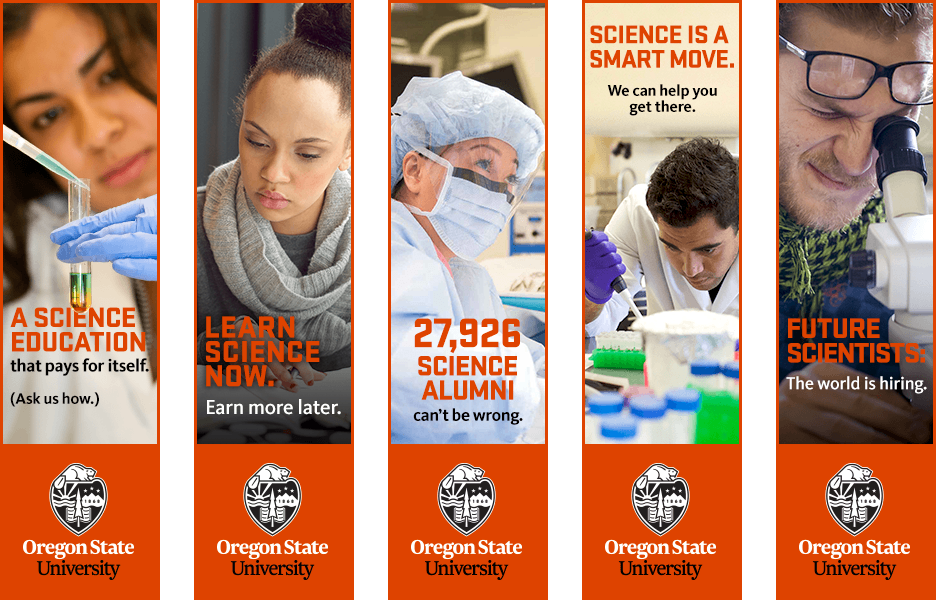
A sample of the digital ads created for the campaign
The marketing campaign runs from July through mid-August. Early results are encouraging: The click through rate of emails of 0.8% is well above the national average for education email marketing of .08%. The digital ads brought students to a landing page where they were encouraged to sign up for one of three webinars in July hosted by our College, and OSU Offices of Admissions and Financial Aid to offer immediate, live help to students struggling with enrollment concerns. Although attendance was low, the format and content of the webinar was strong. The recorded webinar is being adapted as an FAQ for new students.
We learned that webinars may not the best medium for today’s students, and are modifying the campaign to drive students with urgent questions to contact Gabrielle James in our Science Success Center. Students can “Ask Gabrielle,” who will provide quick, personalized responses, connect them with the resources they need across campus and follow up with students to ensure they have received answers to their questions.
Through this campaign we hope to provide the kind of strategic yet personal attention to persuade uncertain students that they really do belong at the College of Science this fall, and that we are here to help them achieve their goals.
College visibility
Mathematicians Thomas Dick and Mary E. Pilgrim (Colorado State University) wrote an editorial recently in the Gazette-Times entitled “How math education can catch up to the 21st century.”
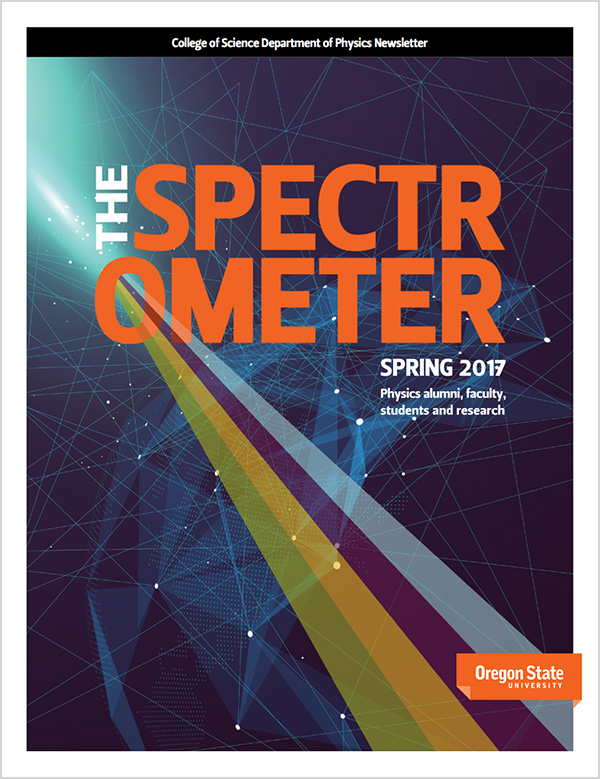
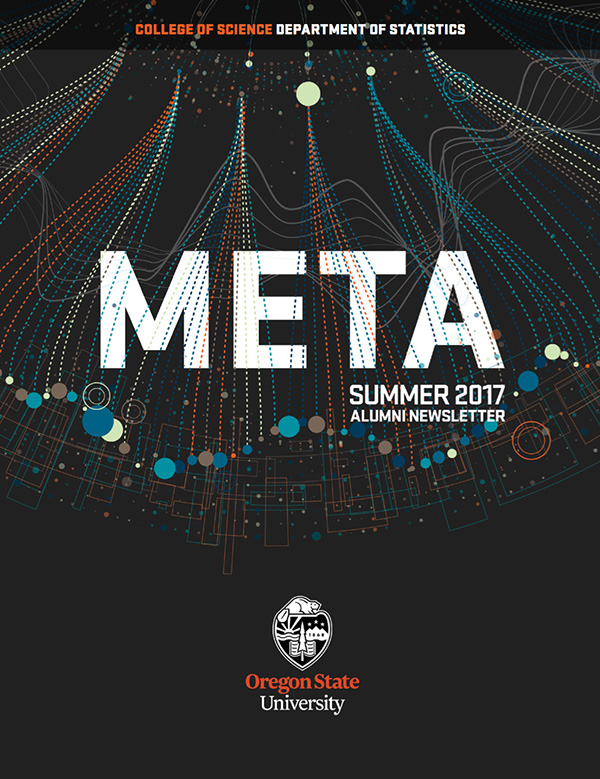
The Physics Department recently published its annual alumni newsletter, The Spectrometer (interactive PDF), and the Statistics Department published the second edition of its annual alumni newsletter, Meta (interactive PDF), this month. Both publications are ways we engage with our alumni and friends to share our impactful research, student/alumni/faculty accomplishments and awards.
Opportunities
The Department of Statistics is currently hiring for a Data Analytics Program Director.
Reminder: All faculty are welcome to apply for the new College of Science Faculty Scholars for Teaching Excellence Award. This newly endowed, three-year faculty scholar position supports excellence and innovation in teaching that advances OSU’s retention and completion goals, with a flexible use of funds ($12,500 per year). Deadline is August 1. We hope to receive a high number of high quality submissions, which may help us raise more funds for additional such endowments this year. Fingers crossed!
The Office of Global Opportunities invites faculty to submit Faculty-led Study Abroad Program Proposals for new or renewing programs beginning Summer 2018 through Spring (Intersession) 2019. Note: Deadline is August 31 to initiate a proposal in time to recruit fall students.
OMSI is inviting applications for the fall cohort of the Science Communication Fellowship program. Deadline: August 7.

Events
Event Videos
If you missed any of our special events and lectures this past spring, please visit our YouTube channel and watch the videos. Recent posts include:
- Ed Yong Lecture, part of the OSU Microbiome Initiative
- Gilfillan Lecture “The Garden of Eden Revisited” featuring Bob Mason
- Earth Day event, Science Worth Spreading, panel discussion of science faculty
Save the Date
July 31–August 5.
Genetic Code Expansion Workshop: Hosted by the Department of Biochemistry and Biophysics. The workshop welcomes scientists from around the country to participate in this intensive laboratory and lecture course focused on the theoretical and practical knowledge needed to utilize existing and emerging genetic code expansion technology.
August 3-6, August 10-13.
Don’t miss the annual Bards in the Quad production. This year OSU is presenting Shakespeare’s comedy The Two Gentlemen of Verona. So pack a picnic and join the fun for the 11th year of this OSU summer tradition. Performances are August 3-6 and August 10-13 at 7:30 pm on the Memorial Union Quad.
August 4.
BioNMR Symposium: Hosted by the Department of Biochemistry and Biophysics. This one-day symposium focuses on how NMR illuminates biology. The event features seminars by internationally recognized NMR scientists, a poster session, research talks by students and postdocs, a career session and networking opportunities.
August 8.
OMSI Workshops: OMSI is offering two half-day workshops for eight STEM-based professionals highlighting different aspects of communication in science: “Developing Your Message” and “PowerPoint Data Visualization.
August 19–21.
Solar Eclipse Celebration: OSU’s 150th anniversary (called OSU150) kicks off with a three-day Space-Grant festival celebrating the eclipse! Free and open to the public. (Calendar of events.)
September 21
2017 College of Science Faculty and Staff Awards, Horizon Room, Memorial Union, 5–6:30 p.m.
October 6-8
The Department of Microbiology is hosting the 2017 Crown Gall Meeting, a premier international conference that attracts more than 100 researchers from top universities, industry, teaching colleges and research institutes who are interested in agrobacterium biology and plant biotechnology. Microbiology Professor Walt Ream is co-organizing the annual event along with others in the College of Agricultural Sciences. Postdoctoral, graduate and undergraduate students and senior investigators are encouraged to present talks.
Oct. 27–29
The Department of Mathematics will host the 1st Biennial Meeting of the Society for Industrial and Applied Mathematics Pacific Northwest Section (SIAMPNWS).
